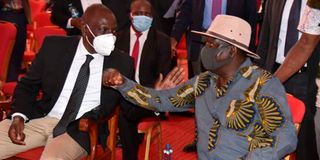As Ruto’s credibility soared, Odinga’s continued to spiral

Deputy President William Ruto (left) confers with ODM party leader Raila Odinga during the burial service of the late MP of Matungu Justus Murunga at Makunda Primary School grounds Matungu in Kakamega County on December 5, 2020.
What you need to know:
- Raila has secured the endorsement of virtually every augury monger.
- Although Ruto is well-known throughout Kenya, Odinga turned him into a surprise package at the penultimate stretch of the race.
William Ruto will win the presidential contest handily.
To use Kenya’s wildly hyperbolic vernacular, Ruto will be president by 8 a.m on August 9 and his Kenya Kwanza Alliance will secure a strong governing mandate.
My thesis is handily buttressed by necessary inferences arising from sets of compelling facts and ineluctable circumstances.
Ruto’s principal rival in the contest has secured the endorsement of virtually every augury monger.
However, their prognoses yield abjectly under-critical examination of their statistical premises.
It is a fact that Raila Odinga surrendered his political strongholds without acquiring any new ones to offset the losses, unlike in earlier times.
For example, the loss of the Rift Valley region in 2013 was counteracted by a stronger showing in Western and the acquisition of Eastern.
This effect was by and large maintained in 2017.
In 2022, Odinga undertook a herculean gamble. Like Kipling’s Man, he made a heap of all his political winnings and risked it all in one turn of the pitch in the hope of ‘climbing Mt Kenya’ or chalking Central Kenya to his side of the ledger.
Obsession
He visibly neglected his traditional strongholds and was obsessed with wooing one region, in the face of his rival’s relentless onslaught. Like the Man, he lost everything.
As Odinga pursued his unrequited infatuation, an indefatigable Ruto also swept through his old strongholds and wrested them from the old man’s fading grip.
His command of the Coast, North Eastern, Eastern, Western and significant swathes of Nyanza dissipated, and they are now active battlegrounds where an insurgent Ruto is having a creditable outing indeed.
The hawkers of electoral prognoses have made predictions that do not align with these realities, suggesting that their conclusions are captive to the imperatives of campaign propaganda.
They are difficult to believe, and those that trust in them shall be surprised by the extent of trauma.
So, what happened to Odinga’s strongholds, and his Mt Kenya covetousness? The answer is: William Ruto happened.
Odinga’s campaign was simple: ODM’s cottage industry of arbitrary profiling had worked overtime for decades in portraying Ruto as the ultimate deplorable of Kenya’s politics and peremptorily primed the country to entertain capricious expectations of Ruto as the ultimate ‘Kanu orphan’; a hyper-corrupt anti-reformer and practitioner of primitive tribalism unable to articulate a vision of leadership beyond crude patrimonialism and divisive appeals to primaeval identities.
Conversely, Odinga’s political messaging infrastructure showcased Odinga as Ruto’s antithesis on similarly spurious parameters.
Odinga’s opposition to Kanu was instrumentalised to construct a fallacious if flattering misdescription of Odinga: since Kanu was reactionary, tyrannical, primitive, corrupt and tribalist, Odinga was, by implication, progressive, anti-corruption, reformist and nationalist freedom fighter.
It was never necessary for Odinga to be any of these things in actual fact; through inferential laundering, remembered opposition to Kanu sufficed to purchase him all the necessary encomiums and obliterate his history as a Kanu collaborator, official and minister.
By the same token, Ruto’s stylised Kanu history was strategically remembered to elide his well-documented insurgency and profile as a ‘Kanu rebel’.
Handshake objective
The second limb of Odinga’s anti-Ruto plan was to repurpose the Handshake to achieve the contradictory objectives of ejecting Ruto from the advantages of office whilst encumbering his politics with the onerous overload of incumbency.
At the same time, it was intended that Odinga leverage de facto incumbency scale Mt Kenya and entrench Ruto’s ostracism.
Out of the margins of state power, Ruto thus went to meet Kenyans from a position of perilous perceptual disadvantage.
He relentlessly traversed the country, engaging Kenyans in a dizzying variety of encounters, in virtually every village.
At first, people experienced his generosity and compassion, which seemed bottomless and infinite.
They witnessed his energy, drive and focus first-hand.
What they saw was a kind man, a sober and clear-minded Deputy President, an articulate and persuasive politician, and a devoted leader with a compelling plan and irresistible blueprint to deliver the dreams and aspirations which resonate in every beating Kenyan heart.
The fewer Kenyans saw of the Ruto described by Odinga, the more enamoured of him they became, and the more alienated they became from Odinga and his personality-centred, threadbare and obsolete campaign platform.
Although Ruto is well-known throughout Kenya, Odinga turned him into a surprise package at the penultimate stretch of the race.
As Ruto’s credibility soared, Odinga’s spiralled.
And that is precisely how strongholds crumbled into battlegrounds, and Mt Kenya remained a distant, forbidding prospect lovingly vouchsafed for Ruto, a prodigiously persuasive salesman with an attractive product: the economic liberation of Kenya.
Kenya Kwanza has fielded the largest number of candidates throughout the country, and UDA nominations were a historic spectacle of 5,000 aspirants competing for 888 positions across 36 counties.
This magnitude of demand indicates that Ruto has the goods, and the market cannot have enough of them.
Mr Ng’eno is an Advocate of the High Court of Kenya and a former State House speech writer. @EricNgeno





